How to Fix Audacity ‘Internal PortAudio Error’ in Windows?
Some Windows users are encountering the ‘Internal PortAudio error‘ whenever they attempt to run Audacity. This problem is confirmed to occur with different Audacity version on Windows 7, Windows 8.1, and Windows 10.
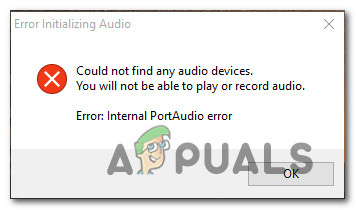
We’ve searched the web for every potential cause that might trigger this error message. And as it turns out, there are several different causes that might cause this problem on Windows 10. Here’s a shortlist with every potential culprit:
- Audacity is not caught up with the latest changes – As it turns out, this problem is often reported to occur if your Audio or recording devices have suffered some changes that Audacity is not already aware of. In this case, you can force the program to catch up with the latest changes by using the Rescan option inside the Transport menu.
- Essential audio service is Disabled – Keep in mind that Audacity requires both the Windows Audio and Windows Audio Endpoint Builder services to be enabled. If this error is occurring because they are disabled, you will be able to fix the problem by accessing the Services Screen and enabling them individually.
- Disabled Playback or Recording device – Another reason why you might end up seeing the ‘Internal PortAudio error is if one or more devices (playback or recording) is disabled from the Sound menu. Generally, it’s better to unplug the device you don’t want to use in Audacity rather than disabling it in order to avoid software confusion.
- Outdated / Corrupted Audio drivers – As some affected users have confirmed, this problem can also occur if you’re dealing with a corrupted or severely outdated audio driver. In this case, you can fix the problem by using Device Manager to uninstall it and find a new version.
- Realtek Audio is conflicting with Windows Update – If you’re still using a Realtek HD audio driver on Windows 10, chances are it’s conflicting with a new Windows Update. If this scenario is applicable, you should uninstall your current version of Realtek and reinstall the latest version from the official download website.
- Corrupted Audacity suite – Under certain circumstances, you can see this error code occurring in situations where you’re actually dealing with some kind of corruption that’s affecting your Audacity installation. In this case, you should be able to fix the problem by reinstalling the entire suite.
- Common Windows 10 glitch – If you’re seeing this issue on Windows 10, you might be dealing with a glitch that’s facilitated by the installation of a new driver. In this case, you can fix the problem by running the Audio Troubleshooter and applying the recommended fix.
- Conflict with DrodCam Virtual Audio driver – If you are trying to use Audacity on an OS installation where you have also installed the Droidcam Virtual Audio driver, chances are the two will end up conflicting and trigger this error. As far as we’ve discovered, this problem can only be fixed by uninstalling the Droidcam driver.
Now that you know every potential culprit, go through every potential fix below in the same order they’re presented. One of them should fix the issue for you:
Method 1: Rescanning Audio Devices in Audacity
As it turns out, Audacity is a little slow in taking into consideration the latest changes you made to your audio devices.
So if you see the ‘Internal PortAudio error‘ right after you made some changes to your audio devices (plugged, unplugged something, or reinstalled drivers), you should be able to fix this problem by forcing Audacity to rescan the Audio Drivers.
This is a universal fix that is confirmed to work in a variety of documented user cases, so ideally, you should start with this.
To force the Audacity program to scan for changes in your Audio Devices, open the app and use the ribbon at the top to click on Transport. Next, from the menu that just appeared, click on Rescan Audio Devices and wait for the operation to complete.
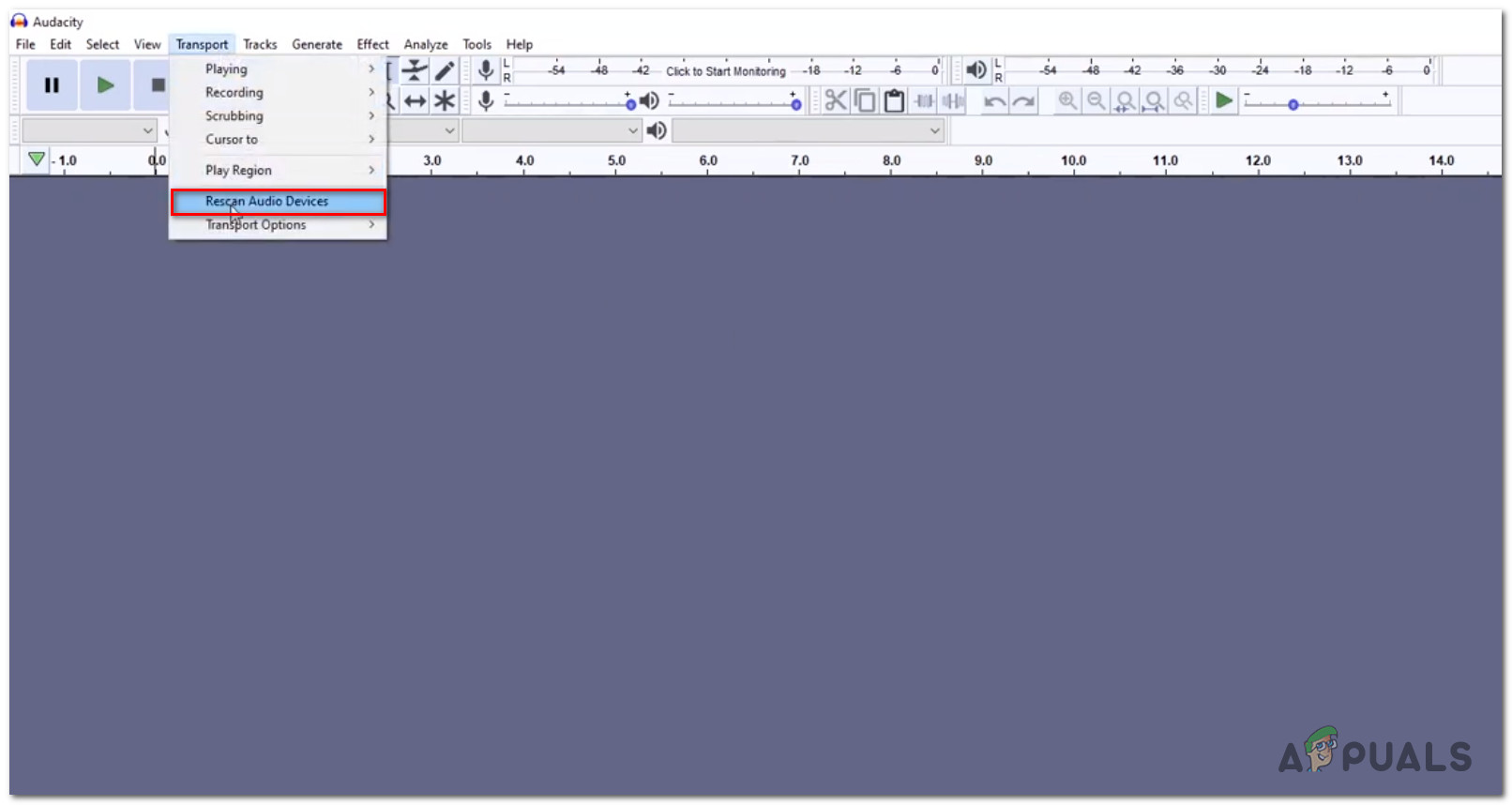
After you do this, go ahead and restart your Audacity program and see if you are now able to open it without seeing the same ‘Internal PortAudio error‘.
If the same problem is still occurring, move down to the next method below.
Method 2: Enabling the necessary Services
According to some affected users, the ‘Internal PortAudio error‘ issue can also occur if you have a couple of critical audio services essential to Audacity (Windows Audio and Windows Audio Endpoint Builder) disabled in your Services menu.
This issue is even more likely if you’re encountering similar sound issues with other applications. In this case, you should be able to fix the problem by accessing the Services screen and ensuring that the two essential services are enabled.
Here’s a step by step guide that will show you how to do this:
- Press Windows key + R to open up a Run dialog box. Next, type ‘services.msc’ inside the text box and press Enter to open up the Services screen.
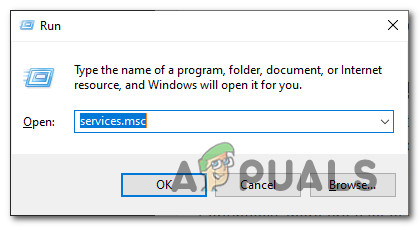
Accessing the Services screen - Once you’re inside the Services screen, scroll down through the list of services and locate the entry associated with Windows Audio. When you see it, right-click on it and choose Properties from the context menu.

Accessing the Properties screen of Windows Audio - Inside the Windows Audio Properties menu, click on the General tab, then change the drop-down menu associated with Startup Type to Automatic before clicking on Apply to save the changes.
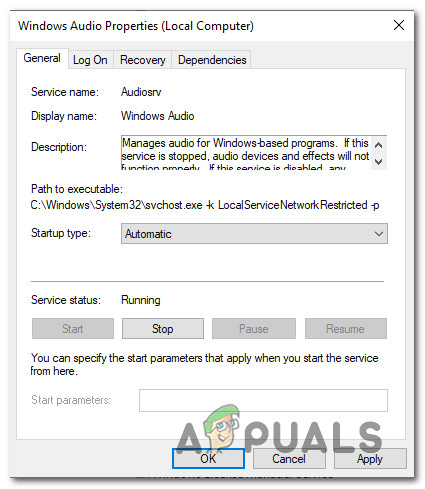
Modifying the properties of Windows Audio - Once you have ensured that the Windows Audio service is enabled, repeat steps 2 and 3 above with the Windows Audio Endpoint Builder service.
- Finally, restart your computer and see if the problem is fixed at the next computer startup.
If the same ‘Internal PortAudio error‘ issue is still occurring, move down to the next potential fix below.
Method 3: Enabling every Playback and Recording Device
First things first, you should start this troubleshooting guide by ensuring that you have no disabled recording and playback device in your Sound menu. This is important because Audacity is notoriously known for malfunctioning when it detects constraints in relation to the devices that it can use.
Fortunately, there are a lot of affected users that managed to fix this issue by going into the Sound menu of their Windows 10 computer and ensuring that there aren’t any disabled devices.
Note: If you have any recording or playback devices that you don’t want Audacity to use, it’s better to plug them out instead of disabling them. This will avoid errors of this kind.
If you’re looking for step-by-step instructions on enabling every playback and recording device, follow the instructions below:
- Press Windows key + R to open up a Run dialog box. Next, type ‘mmsys.cpl’ inside the text box and press Enter to open up the classic Sound window on your Windows 10 computer.
- Once you’re inside the Sound menu, start by clicking on the Playback tab. Once inside, right-click on every device that is disabled (it has the down arrow icon) and choose Enable from the context menu.
- Next, click on the Recording tab and look for any disabled device inside the list below. If you find any, right-click on the disabled device and choose Enable from the context menu.
- After every playback and recording device that was previously disabled is now enabled, click on Apply to save the changes, then reboot your computer.
- Once your computer boots back up, open Audacity once again and see if the problem is now fixed.

In case the same issue is still occurring when you try to open Audacity, move to the next potential fix below.
Method 4: Installing / Reinstalling the audio Drivers
As it turns out, this issue can also occur if you’re dealing with some kind of corruption associated with the sound driver that you’re actively using. Another potential scenario (if you’re using a headset) is that you’re using an outdated driver for playback or recording that’s interfering with Audacity’s ability to recognize your audio devices.
There are a lot of users that confirmed they were able to fix the problem by reinstalling the sound driver and the USB controller driver (if they were using a headset)
Here’s a quick guide on how to do this:
- Press Windows key + R to open up a Run dialog box. Next, type ‘devmgmt.msc’ and press Enter to open Device Manager.

Opening Device Manager from a run box - Once you’re inside Device Manager, scroll down through the list of devices and expand the drop-down menu associated with Sound, video and game controllers. Next, right-click on every Audio device driver listed inside and choose Uninstall.
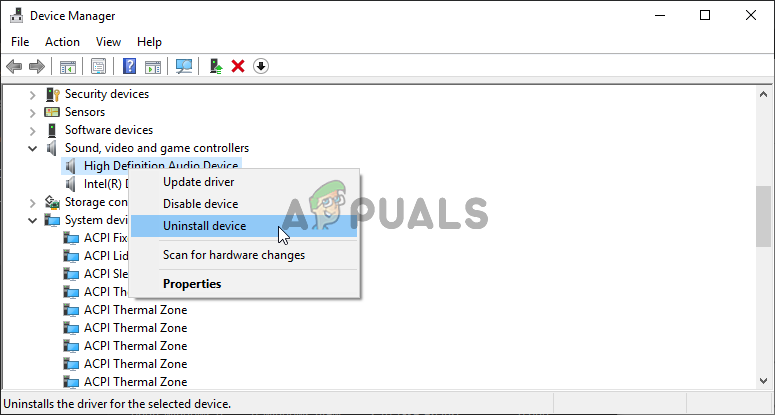
Uninstalling the audio device - After every relevant audio device is uninstalled, go ahead and expand the Universal Serial Bus controller and uninstall every host controller that you see inside.

Uninstalling every host controller Note: This is only applicable if you’re playback or recording devices are connected through a USB port.
- Once every relevant driver is uninstalled, reboot your computer in order to allow your OS to automatically switch over to the generic driver equivalents.
Note: If you’re using a USB-based headset, plug it in in order to allow the initial installation to complete. - Launch Audacity once again and see if the problem is now fixed now that you’re running the generic drivers.
Note: If the issue is still not fixed or you’re now encountering a different error code, you can reinstall the dedicated audio drivers using the official channels.
If the same Internal PortAudio error is still occurring even after you followed the instructions above, move down to the next potential fix below.
Method 5: Reinstalling the Realtek Audio driver (if applicable)
If you’re using Realtek Audio as the default audio driver, chances are you’re seeing this error either because you’re using an outdated version or because your current Realtek installation currently contains some corrupted files that are causing the Internal PortAudio error in Audacity.
If this scenario is applicable, you should be able to fix the problem by uninstalling your current Realtek audio drivers and installing the latest compatible version through the official channels. This potential fix was confirmed to be effective by a lot of affected users.
If you’re looking for step-by-step instructions, follow the instructions below:
- Open up a Run dialog box by pressing Windows key + R. Inside the run box, type ‘appwiz.cpl’ and press Enter to open up the Programs and Features menu.

Accessing the Programs and Features menu (appwiz.cpl) - Inside the Programs and Features prompt, go ahead and scroll down through the list of applications and locate the Realtek HD Manager (or a different audio driver signed by Realtek)
- When you locate the correct driver, right-click on it and choose Uninstall from the context menu, then follow the on-screen prompts to complete the installation.
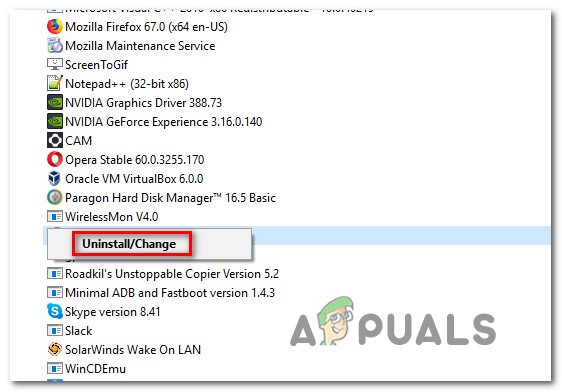
Uninstalling the Realtek driver Note: If you have multiple tools from Realtek, our recommendation is to uninstall everything and start from scratch.
- After every Realtek driver is finally uninstalled, reboot your computer and wait for the next startup to complete.
- Open your default browser and navigate to the official download page of Realtek audio driver and download the latest version.
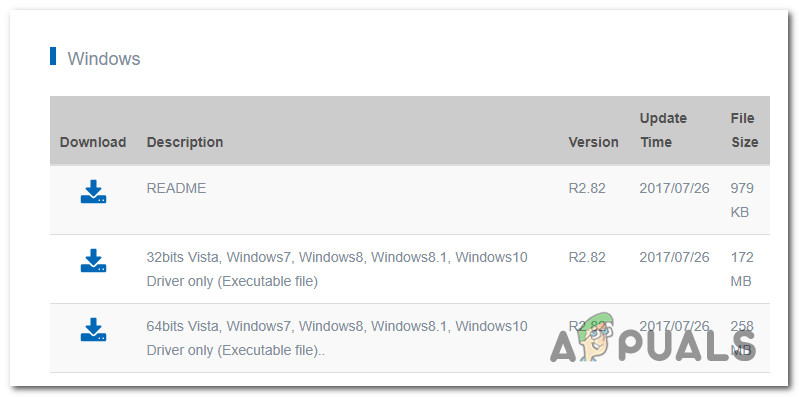
Downloading the latest Realtek driver Note: Ensure that you downloading the correct driver according to your OS architecture (32-bit or 64-bit).
- Once the download is complete, open the installer and follow the on-screen prompts to reinstall the latest version of the Realtek driver.
- Finally, once the installation is complete, restart your computer one final time and see if you’re still seeing the same error when you’re trying to open Audacity.
In case the same ‘Internal PortAudio error is still occurring, move down to the next potential fix below.
Method 6: Reinstalling the Audacity Suite
According to some affected users, this problem can also occur due to some kind of corruption that’s currently affecting the current Audacity installation. And since Audacity doesn’t have a reliable auto-updating function, it’s also possible that the version you’re using is conflicting with a Windows update that was recently pushed by Microsoft.
If this scenario is applicable, you should be able to fix the problem by uninstalling your current Audacity version and installing the latest version from the official download page.
In case you’re looking for step-by-step instructions, follow the instructions below:
- Open up a Run dialog box by pressing Windows key + R. Next, type ‘appwiz.cpl’ and press Enter to open up the Programs and Features screen.

Opening the Programs and Features menu - Once you’re inside the Programs and Features menu, scroll down through the list of currently installed applications and locate the current installation of Audacity. When you see it, right-click on it and choose Uninstall from the context menu.

Uninstalling the current version of Audacity - Inside the uninstallation screen, follow the on-screen prompts to complete the uninstallation procedure, then restart your computer and wait for the next startup to complete.
- Once your computer boots back up, open your default browser and visit the official download page of Audacity. Once you’re inside, download the latest version available by clicking on Audacity for Windows from the list of available options. Next, from the list of available executables, download Audacity WIndos Installer.
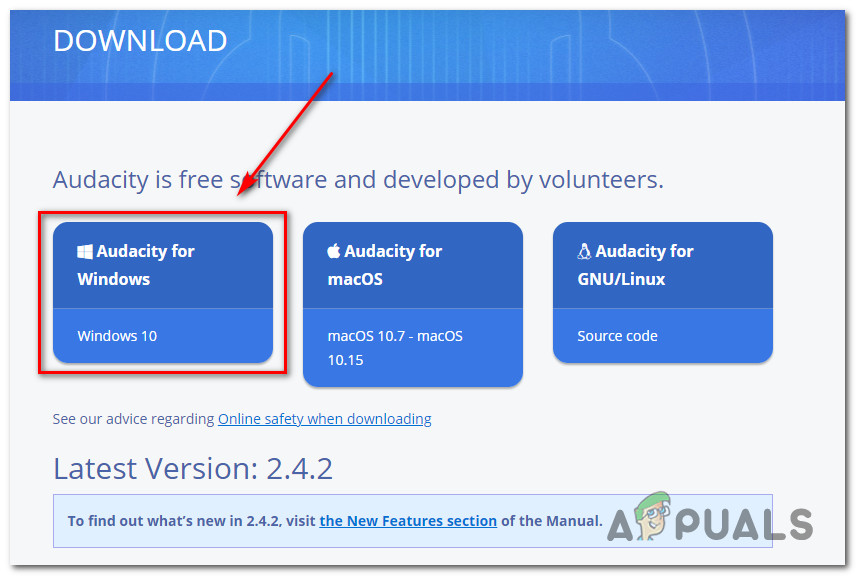
Downloading the latest version of Audacity for Windows - Once the download is finally complete, double-click on the executable that you just downloaded and follow the on-screen instructions to complete the installation of the latest version of Audacity.
Method 7: Running the Audio Troubleshooter (Windows 10 ONLY)
If none of the methods above have worked for you, you should also consider the possibility of a frequent Windows-related glitch that is affecting your audio device. Fortunately, Windows 10 includes a built-in tool that’s very efficient in fixing situations like this one by running the Audio Troubleshooter and applying the recommended fix.
This potential fix is confirmed to work by a lot of affected users that whee previously seeing the ‘Internal PortAudio error‘ when attempting to open the Audacity application.
If you didn’t run this type of scan before, here’s a quick step-by-step guide on how to do it:
- Open up a Run dialog box by pressing Windows key + R. Next, type ‘ms-settings:troubleshoot’ and press Enter to open up the Troubleshooting tab of the Settings app.
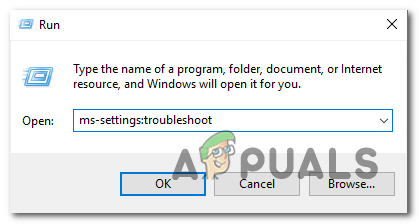
Accessing the Troubleshooting tab on Windows 10 - Next, from the Troubleshooting tab, scroll all the way down to the Get up and running category and click on Playing Audio. Next, click on Run the troubleshooter to open the utility.

Running the Audio troubleshooter on Windows 10 - After you start the scan, wait until the initial investigation is complete. If a problem is identified, click on Apply this fix and follow the remaining instructions if necessary to enforce the fix.
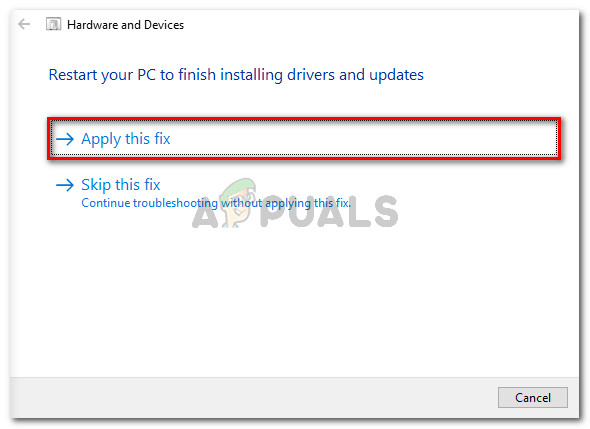
Applying the recommended fix - Finally, once the fix was successfully enforced, restart your computer and see if the problem is fixed at the next computer startup.
If the same issue is still occurring, move down to the final potential fix below.
Method 8: Uninstalling DroidCam Virtual Audio Driver (if applicable)
If none of the potential fixes above have worked for you and you’re using Droidcam, you’re most likely dealing with a well-known conflict that is affected Windows 10 users that are using Audacity on an OS installation where a Droidcam driver is also installed.
If this scenario is applicable, the only way to fix the problem is to uninstall the audio driver from DroidCam. I know this is not the ideal fix, but it’s the only thing that works in this particular scenario.
Here’s what you need to do to eliminate the conflict:
- Open up a Run dialog by pressing Windows key + R. Next, type ‘appwiz.cpl’ and press Enter to open up the Programs and Features menu.

Opening the Programs and Features menu - Once you’re inside the Programs and Features menu, scroll down through the list of installed programs and locate the Droidcam Virtual Audio entry.
- When you see it, right-click on it and choose Uninstall from the context menu. Next, follow the on-screen prompts to complete the uninstallation process.
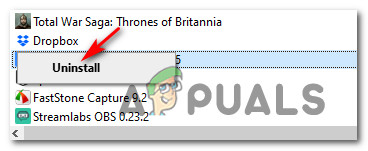
Uninstalling Droidcam Virtual Audio driver - After your computer boots back up, open Audacity, and see if the problem is fixed once the next startup is complete.





